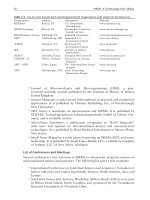- Trang chủ >>
- Khoa Học Tự Nhiên >>
- Vật lý
nanotechnology. an introduction to nanostructuring techniques, 2007, p.335
Bạn đang xem bản rút gọn của tài liệu. Xem và tải ngay bản đầy đủ của tài liệu tại đây (5.84 MB, 335 trang )
Michael Ko¨hler and
Wolfgang Fritzsche
Nanotechnology
Each generation has its unique needs and aspirations. When Charles Wiley first
opened his small printing shop in lower Manhattan in 1807, it was a generation
of boundless potential searching for an identity. And we were there, helping to
define a new American literary tradition. Over half a century later, in the midst
of the Second Industrial Revolution, it was a generation focused on building
the future. Once again, we were there, supplying the critical scientific, technical,
and engineering knowledge that helped frame the world. Throughout the 20th
Century, and into the new millennium, nations began to reach out beyond their
own borders and a new international community was born. Wiley was there, ex-
panding its operations around the world to enable a global exchange of ideas,
opinions, and know-how.
For 200 years, Wiley has been an integral part of each generation’s journey,
enabling the flow of information and understanding necessary to meet their
needs and fulfill their aspirations. Today, bold new technologies are changing
the way we live and learn. Wiley will be there, providing you the must-have
knowledge you need to imagine new worlds, new possibilities, and new oppor-
tunities.
Generations come and go, but you can always count on Wiley to provide you
the knowledge you need, when and where you need it!
William J. Pesce Peter Booth Wiley
President and Chief Executive Officer Chairman of the Board
1807–2007 Knowledge for Generations
Michael Ko¨hler and Wolfgang Fritzsche
Nanotechnology
An Introduction to Nanostructuring Techniques
Second, Completely Revised Edition
The Editors of this Volume
Prof. Dr. Michael Ko¨hler
Technische Universita¨t Ilmenau
Institut fu¨r Physik
Postfach 100 565
98684 Ilmenau
Dr. Wolfgang Fritzsche
Institut fu¨r Photonische Technologien
Abteilung fu¨r Nanobiophotonik
Postfach 100 239
07702 Jena
Cover
The background of the front cover design shows a
fragment of Richard P. Feynman’s famous classic
talk “There‘s Plenty of Room at the Bottom” given
on December 29, 1959. Reproducted with kind
permission of Caltech’s Engineering & Science
magazine (1960, 23, 22 – 36). Feynman’s visionary
speech can be read in full length at
/>The Text has been written on a gold surface by
Chad Mirkin’s group using Dip-Pen
Nanolithography
( />htm); notice that for example an “I” is 60 nm of
width. Chapter 4.4 of this book deals with these
kinds of techniques.
All books published by Wiley-VCH are carefully
produced. Nevertheless, authors, editors and
publisher do not warrant the information
contained in these books, including this book, to
be free of errors. Readers are advised to keep in
mind that statements, data, illustrations,
procedural details or other items may
inadvertently be inaccurate .
Library of Congress Card No.: applied for
British Library Cataloguing-in-Publication
Data:
A catalogue record for this book is
available from the British Library.
Bibliographic information published by
the Deutsche Nationalbibliothek
The Deutsche Nationalbibliothek lists this
publication in the Deutsche Nationalbibliografie;
detailed bibliographic data is available in the
Internet at
ª 2007 Wiley-VCH Verlag GmbH & Co. KGaA,
Weinheim
All rights reserved (including those of translation
in other languages). No part of this book may be
reproduced in any form – by photoprinting,
microfilm, or any other means – nor transmitted
or translated into machine language without
written permission from the publishers.
Registered names, trademarks, etc. used in this
book, even when not specifically marked as such,
are not to be considered unprotected by law.
Printed in the Federal Republic of Germany.
Printed on acid-free paper
Composition Mitterweger & Partner GmbH,
Plankstadt
Printing Strauss GmbH, Mo¨rlenbach
Bookbinding Litges & Dopf Buchbinderei GmbH,
Heppenheim
Wiley Bicentennial Logo Richard J. Pacifico
ISBN 978-3-527-31871-1
Contents
1 Introduction 1
1.1 The Way into the Nanoworld 1
1.1.1 From Micro- to Nanotechniques 1
1.1.2 Definition of Nanostructures 2
1.1.3 Insight into the Nanoworld 3
1.1.4 Intervention into the Nanoworld 4
1.2 Building Blocks in Nanotechnology 5
1.3 Interactions and Topology 7
1.4 The Microscopic Environment of the Nanoworld 9
2 Molecular Basics 13
2.1 Particles and Bonds 13
2.1.1 Chemical Bonds in Nanotechnology 13
2.1.2 Van der Waals Interactions 14
2.1.3 Dipole–Dipole Interactions 14
2.1.4 Ionic Interactions 16
2.1.5 Metal Bonds 16
2.1.6 Covalent Bonds 17
2.1.7 Coordinative Bonds 19
2.1.8 Hydrogen Bridge Bonds 20
2.1.9 Polyvalent Bonds 20
2.2 Chemical Structure 23
2.2.1 Binding Topologies 23
2.2.2 Building Blocks of Covalent Architecture 24
2.2.3 Units for a Coordinative Architecture 27
2.2.4 Building Blocks for Weakly Bound Aggregates 27
2.2.5 Assembly of Complex Structures through the Internal Hierarchy of
Binding Strengths
28
2.2.6 Reaction Probability and Reaction Equilibrium 29
3 Microtechnological Foundations 33
3.1 Planar Technology 33
3.2 Preparation of Thin Layers 37
V
Nanotechnology. M. Ko¨hler and W. Fritzsche
Copyright ª 2007 WILEY-VCH Verlag GmbH & Co. KGaA, Weinheim
ISBN: 978-3-527-31871-1
3.2.1 Condition and Preprocessing of the Substrate Surface 37
3.2.2 Layer Deposition from the Gas Phase 39
3.2.3 Evaporation 42
3.2.4 Sputtering 43
3.2.5 Chemical Vapor Deposition 46
3.2.6 Galvanic Deposition 48
3.2.7 Deposition by Spinning (Spin Coating) 50
3.2.8 Shadow-mask Deposition Techniques 53
3.3 Preparation of Ultrathin Inorganic Layers and Surface-bound
Nanoparticles
54
3.3.1 Ultrathin Layers by Vacuum Deposition Processes 54
3.3.2 Deposition of Ultrathin Films from the Liquid Phase 55
3.3.3 In Situ Generation of Ultrathin Inorganic Films by Chemical Surface
Modification
56
3.3.4 In Situ Formation of Ultrathin Inorganic Layers on Heteroorganic
Materials
57
3.3.5 Immobilization of Nanoparticles 58
3.3.6 In Situ Formation of Inorganic Nanoparticles 59
3.4 Structure Generation and Fabrication of Lithographic Masks 59
3.4.1 Adhesive Mask Technique 59
3.4.2 Role of Resist in Photolithography 63
3.4.3 Serial Pattern Transfer 64
3.4.4 Group Transfer Processes 67
3.4.5 Maskless Structure Generation 68
3.4.6 Soft Lithography 68
3.5 Etching Processes 70
3.5.1 Etching Rate and Selectivity 70
3.5.2 Isotropic and Anisotropic Etching Processes 71
3.5.3 Lithographic Resolution in Etching Processes 72
3.5.4 Wet Etching Processes 73
3.5.5 Dry Etching Processes 76
3.5.6 High-resolution Dry Etching Techniques 78
3.5.7 Choice of Mask for Nanolithographic Etching Processes 80
3.6 Packaging 80
3.7 Biogenic and Bioanalogue Molecules in Technical Microstructures 84
4 Preparation of Nanostructures 87
4.1 Principles of Fabrication 87
4.1.1 Subtractive and Additive Creation of Nanostructures 87
4.1.2 Nanostructure Generation by Lift-off Processes 89
4.1.3 Principles of Nanotechnical Shape-definition and Construction 91
4.2 Nanomechanical Structure Generation 96
4.2.1 Scaling Down of Mechanical Processing Techniques 96
4.2.2 Local Mechanical Cutting Processes 97
4.2.3 Surface Transport Methods 97
ContentsVI
4.2.4 Reshaping Processes 98
4.2.5 Soft Lithography for Nanopatterning and Nanoimprinting 101
4.3 Nanolithography 105
4.3.1 Structure Transfer by Electromagnetic Radiation 105
4.3.2 DUV- and Vacuum-UV Lithography 108
4.3.3 EUV and X-ray Lithography 110
4.3.4 Multilayer Resist Techniques with Optical Pattern Transfer 113
4.3.5 Near-field Optical Micropatterning Techniques 114
4.3.6 Energetic Particles in Nanolithographic Structure Transfer 116
4.3.7 Electron Beam Lithography 117
4.3.8 Ion Beam Lithography 124
4.3.9 Atomic Beam Lithography 126
4.3.10 Molecular and Nanoparticle Beam Lithography 126
4.3.11 Direct Writing of Structures by a Particle Beam 127
4.3.12 Nanostructure Generation by Accelerated Single Particles 130
4.3.13 Patterning by Local Chemical Conversion 132
4.3.14 Nanofabrication by Self-structuring Masks 132
4.4 Nanofabrication by Scanning Probe Techniques 133
4.4.1 Mechanical Surface Modifications based on Scanning Force Microscopy
(SFM)
134
4.4.2 Manipulation by a Scanning Tunneling Microscopy (STM) 135
4.4.3 Thermo-mechanical Writing of Nanostructures 137
4.4.4 Electrically Induced Structure Generation by Scanning Probe Techni-
ques
138
4.4.5 Chemical Induced Scanning Probe Structure Generation 143
4.4.6 Nanostructure Generation by Optical Near-field Probes 145
4.4.7 Scanning Probe Methods for Nanoscale Transfer 146
4.5 Reduction of Feature Sizes by Post-Lithographic Processing 146
4.5.1 Narrowing of Nanogaps by Material Deposition 146
4.5.2 Size Reduction by Thermally Induced Reshaping 147
4.5.3 Size Reduction by Sidewall Transfer 148
4.5.4 Formation of Nanodots by Dewetting 148
5 Nanotechnical Structures 149
5.1 Nanostructures and Nanomaterials 149
5.2 Inorganic Solids 150
5.2.1 Influence of Material Morphology on Nanoscale Pattern Processes 150
5.2.2 Inorganic Dielectrics 150
5.2.3 Metals 152
5.2.4 Semiconductors 154
5.3 Carbon Nanostructures 156
5.4 Organic Solids and Layer Structures 158
5.4.1 Solids Composed of Smaller Molecules 158
5.4.2 Organic Monolayer and Multilayer Stacks 158
5.4.3 Synthetic Organic Polymers 160
Contents VII
5.4.4 Biopolymers 161
5.5 Molecular Monolayer and Layer Architectures 162
5.5.1 Langmuir–Blodgett Films 162
5.5.2 Self-assembled Surface Films 164
5.5.3 Binding of Molecules on Solid Substrate Surfaces 165
5.5.4 Secondary Coupling of Molecular Monolayers 167
5.5.5 Categories of Molecular Layers 168
5.5.6 Molecular Coupling Components (Linkers) and Distance Components
(Spacers)
171
5.5.7 Definition of Binding Spots on Solid Substrates 172
5.6 Molecular Architectures 174
5.6.1 Single Molecules as Nanostructures 174
5.6.2 Strategies of Molecular Construction 178
5.6.3 Biogenic and Bio-analogous Nanoarchitectures 182
5.6.4 DNA Nanoarchitectures 185
5.6.5 Synthetic Supramolecules 192
5.6.6 Nanoparticles and Nanocompartments 200
5.7 Combination of Molecular Architectures and Nanoparticles With Planar
Technical Structures
202
6 Characterization of Nanostructures 211
6.1 Geometrical Characterization 211
6.1.1 Layer Thickness and Vertical Structure Dimensions 211
6.1.2 Lateral Dimensions 215
6.1.3 Structures that Assist Measurement 216
6.2 Characterization of Composition of Layers and Surfaces 217
6.2.1 Atomic Composition 217
6.2.2 Characterization of the Chemical Surface State 220
6.3 Functional Characterization of Nanostructures 223
7 Nanotransducers 225
7.1 Design of Nanotransducers 225
7.2 Nanomechanical Elements 227
7.2.1 Nanomechanical Sensors 227
7.2.2 Nanometer-precision Position Measurements with Conventional
Techniques
228
7.2.3 Electrically Controlled Nanoactuators 228
7.2.4 Chemically Driven Nanoactuators 230
7.2.5 Rigidity of Nanoactuators 234
7.3 Nanoelectronic Devices 235
7.3.1 Electrical Contacts and Nanowires235
7.3.2 Nanostructured Tunneling Barriers
240
7.3.3 Quantum Dots and Localization of Elementary Particles 242
7.3.4 Nanodiodes 243
7.3.5 Electron Islands and Nanotransistors 244
ContentsVIII
7.3.6 Nanoswitches, Molecular Switches and Logic Elements 251
7.3.7 Particle-Emitting Nanotransducers 253
7.4 Nanooptical Devices 254
7.4.1 Nanostructures as Optical Sensors 254
7.4.2 Nanostructured Optical Actuators 255
7.4.3 Nanooptical Switching and Conversion Elements 257
7.5 Magnetic Nanotransducers 258
7.6 Chemical Nanoscale Sensors and Actuators 260
7.8 Nanochannels and Nanofluidic Devices 265
7.8.1 Nanochannel Arrays 267
7.8.2 Nanofluidic Electrospraying 269
7.8.3 Liquid Transport in Nanotubes 269
7.8.4 Nanofluidic Actuators for Optical Application 269
7.8.5 Functional Molecular Devices for Nanofluidics 269
8 Technical Nanosystems 271
8.1 What are Nanosystems? 271
8.2 Systems with Nanocomponents 272
8.3 Entire Systems with Nanometer Dimensions 273
Table of Examples 279
References 283
Index 307
Contents IX
Abbreviations and Acronyms
AES Auger electron spectroscopy
AFM atomic force microscopy
ALE atomic layer epitaxy
ATP adenosine triphosphate
BSE back-scattered electron
CBO coulomb blockade oscillations
CFL capillary force lithography
CFS chemical force spectroscopy
CMP chemical-mechanical polishing
CNT carbon nanotube
cNW-FET crossed nanowire field-effect transistor
DGL diffraction gradient lithography
DLP diffusion-limited patterning
DNM double-negative material
DPN dip-pen nanolithography
DUV deep ultraviolet
EBD electron-beam deposition
EBDL electron-beam deposition lithography
EBIT electron-beam-induced deposition
EBL electron-beam lithography
ECR electron cyclotron resonance etching
EDX energy-dispersive X-ray spectroscopy
ESCA electron spectroscopy for chemical analysis (XPS)
EUV extreme ultraviolet
EUVL extreme-ultraviolet lithography
FIB focussed ion beam
FIBL focussed ion beam lithography
HD high density
HSQ hydrogen silsesquioxane
IL interferometric lithography
ISL iterative spacer lithography
ITO indium tin oxide
ITRS International Technology Roadmap for Semiconductors
X
Nanotechnology. M. Ko¨hler and W. Fritzsche
Copyright ª 2007 WILEY-VCH Verlag GmbH & Co. KGaA, Weinheim
ISBN: 978-3-527-31871-1
LB film Langmuir Blodgett film
LEEB low-energy electron beam
LEEBDW low-energy electron-beam direct writing
LEESR low-energy electron-stimulated reaction
MALDI matrix-assisted laser desorption/ionization
MBS multi-beam source
MC molecule cluster
MHA mercaptohexanoic acid
MOSFET metal-oxide-semiconductor field-effect transistor
MTJ magnetic tunnel junction
MWNT multi-wall carbon nanotubes
NCA nanochannel alumina
NEMS nanoelectromechanical systems
NFL near-field lithography
NIL nano imprint lithography
NL Novolak
ODT octadecanethiol
OMVPE organometallic vapor-phase epitaxy
PAAF porous anodic alumina films
PC polycarbonate
PDMS polydimethylsiloxane
PE polyethylene
PE-CVD physically enhanced chemical vapor deposition
PEPE perfluoropolyether
PET plasma etching
PET poly(ethylene-terephthalate)
PHOST poly(hydroxystyrene)
PMMA poly(methyl methacrylate)
PPP poly(para-phenylene)
PUA poly(urethane acrylate)
PXL proximity X-ray lithography
QCA quantum-dot cellular automata
QD quantum dot
QDD quantum dot devices
RIE reactive ion etching
RSL reversed spacer lithography
SE secondary electron
SED single-electron devices
SEM scanning electron microscopy
SERS surface-enhanced Raman scattering
SET single-electron tunneling
SIMS secondary ion mass spectrometry
SOI silicon on insulator
SOQD self-organized quantum dots
SPL surface plasmon lithography
Abbreviations and Acronyms XI
SPM scanning probe microscopy
SPR surface plasmon resonance
SPRINT surface plasmon resonant interference nanolithography technique
SST solid-state technology
STL sidewall transfer lithography
STM scanning tunneling microscopy
TEM transmission electron microscopy; transmission electron microscope
TF thermal flow
TMAH tetramethylammonium hydroxide
TRR tunnel resonance resistor
TSI terrascale integration (in electronics: more than 1 trillion transistors
per chip)
UHV ultra-high vacuum
VTD vapor transport deposition
WDX wavelength-dispersive X-ray spectroscopy
WE wet etching
XPS X-ray photoelectron spectroscopy
XRL X-ray lithography (Roentgen lithography)
ZPAL zone-plate array lithography
Abbreviations and AcronymsXII
1
Introduction
1.1
The Way into the Nanoworld
1.1.1
From Micro- to Nanotechniques
Microtechnology has changed our lives dramatically. The most striking impact is ap-
parent in computer technology, which is essential for today’s industry, and also for our
individual life styles. Apart from microelectronics, microtechnology influences many
other areas. The size of typical structures that is accessible is in the sub-micrometer
range, which is at the limits of optical resolution and barely visible with a light micro-
scope. This is about 1/1000 smaller than structures resolvable by the naked eye, but
still 1000 times larger than an atom. Today’s developments are addressing the size
range below these dimensions. Because a typical structure size is in the nanometer
range, the methods and techniques are defined as nanotechnology.
The consequent extension of the resolution limit of microscopes led to instruments
with the capacity to resolve features below the wavelength of light: the field ion micro-
scope, the electron microscope, and finally the family of scanning probe microscopes.
Now it is possible to image individual molecules, and even single atoms.
Although chemistry and microtechnology appear to be fundamentally different, they
are somehow related. They have mutual interests in the area of properties of materials.
Microtechnology is not a simple extrapolation of conventional precise mechanical
methods down to smaller dimensions. Chemical methods, such as plasma pro-
cesses, wet chemical etching and photo resist techniques, are predominant compared
with cutting or reshaping processes. However, microtechnology follows physical prin-
ciples. As in classical chemistry, chemical processes in microtechnology use a rela-
tively high number of similar particles. Individual particles play no dominant role,
whether in fabrication methods or in applications.
In nanotechnology, the primary role of classical physical principles is replaced as
molecular and atomic dimensions are approached. Physical–technical and chemical
aspects influence the fabrication and the use and application of nanotechnical struc-
tures on an equal basis. The effects of mesoscopic physics, a field that is influenced by
and uses quantum phenomena, complement these aspects. In contrast to classical
chemistry, small ensembles or even individual particles can play a decisive role.
Nanotechnology. M. Ko¨hler and W. Fritzsche
Copyright ª 2007 WILEY-VCH Verlag GmbH & Co. KGaA, Weinheim
ISBN: 978-3-527-31871-1
11
The nanotechnology literature often focuses on the structure size and differentiates
between two basic approaches. The Top-down approach tries to enhance the methods
from microtechnology to achieve structure sizes in the medium and also lower nan-
ometer range. This approach is based on a physical and microlithographic philosophy,
which is in contrast to the other approach, where atomic or molecular units are used to
assemble molecular structures, ranging from atomic dimensions up to supramolecu-
lar structures in the nanometer range. This Bottom-up approach is mainly influenced
by chemical principles.
The challenge of modern nanotechnology is the realization of syntheses by the Top-
down and Bottom-up approaches. This task is not driven entirely by the absolute struc-
ture dimensions, because today macro- and supramolecules extending up to hundreds
of nanometers or even micrometers can already be synthesized or isolated from bio-
logical systems. So the overlap of both approaches is not a problem. Both techniques
provide specific capabilities that can be implemented by the other. The lithographic
techniques (Top-down) offer the connection between structure and technical environ-
ment. The interface with the surrounding system is given in this approach, but it is not
really possible with the chemical (Bottom-up) approach. At the same time, the integra-
tion of nanostructures into a functional microtechnical environment is realized. On
the other hand, chemical technologies provide adjustment of chemical binding
strength and preferred orientation of bonds, together with a fine tuning according
to the numbers of bound atoms or atomic groups and a classification of the spatial
orientation based on the number of bonds and their angles.
Therefore, nanotechnology depends on both classical microtechnology, especially
microlithography, and chemistry, in particular interfacial and surface chemistry
and supramolecular synthesis. Additional basic methods are molecular biology and
biochemistry, because nature has provided, with the existence of large molecules
and supramolecular complexes, not only examples, but also interesting technical tools
[1][2][3]. In the following sections, microtechnical and molecular basics are discussed,
prior to particular methods for the creation of nanostructures, their characterization
and application.
1.1.2
Definition of Nanostructures
A clear distinction between nanostructures and microstructures is given here arbitra-
rily using length measurements. Nanostructures are defined according to their geo-
metrical dimensions. This definition addresses technical dimensions, induced by ex-
ternal shaping processes, with the key feature being that the shaping, the orientation
and the positioning is realized relative to an external reference system, such as the
geometry of a substrate. Of less importance is whether this process uses geometrical
tools, media or other instruments.
A narrow definition of nanostructures is that they include structures with at least
two dimensions below 100 nm. An extended definition also includes structures with
one dimension below 100 nm and a second dimension below 1 lm. Following on from
1 Introduction2
this definition, ultra thin layers with lateral sub-micrometer structure sizes are also
nanostructures.
All spontaneously distributed or spontaneously oriented structures in materials and
on surfaces are not incorporated in nanotechnical structures. However, this does not
exclude the presence of such structures in nanotechnical setups, as long as their di-
mensions are in accord with the above-mentioned criteria. Also microstructured ul-
trathin layers are excluded, because they exhibit only one nanometer dimension. Na-
nodevices are devices with at least one essential functional component that is a nanos-
tructure. Nanosystems consist of several nanodevices that are of importance to the
functioning of the whole system.
1.1.3
Insight into the Nanoworld
The realization that there are small things in the world that are not visible to the naked
eye extends back into human history. The development of the natural sciences created
an interest in the microworld, in order to enable a better understanding of the world
and the processes therein. Therefore, the development of new microscopic imaging
methods represents certain milestones in the natural sciences. The microworld was
approached by extending the range available for the direct visualization of objects
through the enhancement of microscopic resolution.
Access to spatial modifications in the nanoworld is not limited to one direction.
Long before instruments were available for the imaging of molecules, an understand-
ing of the spatial arrangements of atoms in molecules and solids, in disperse systems
and on surfaces had been developed. The basis for this development was the antici-
pation of the existence of small building elements, which extended back to Greek
philosophers (Leukip and Demokrit: “atomos” – the indivisible = smallest unit).
This hypothesis was confirmed by Dalton with the discovery of stoichiometry as a
quantitative system in materials: chemical reactions are comprised of fixed ratios
of reactant masses. Based on the systematic organization of chemical elements, devel-
oped by D
€
oobereiner, Meyer and Mendeleyev, into the Periodic Table of the elements,
and supplemented by models of the internal structure of atoms, a new theory of the
spatial connection of atoms was created: the theory of chemical bonds. It not only
defines the ratios of atoms involved in a reaction, but leads also to rules for the spatial
arrangement of atoms or group of atoms. We know today that the immense variety of
solid inorganic compounds and organisms is based on this spatial arrangement of
chemical bonds. Stoichiometry and geometry describe the chemical aspects of mole-
cules and solids. The stability and the dynamics of chemical changes are determined
by the rates of possible reactions that are based on thermodynamics and kinetics. Key
contributions to the understanding of the energetic and kinetic foundations came
from Clausius, Arrhenius and Eyring.
1.1 The Way into the Nanoworld 33
1.1.4
Intervention into the Nanoworld
The scientific understanding of the molecular world and the application of quantitative
methods laid the foundations of modern chemistry. Before the quantification of che-
mical reactions, there was already an applied area of chemistry, for example in mining
or metallurgy. However, it was established through an empirical approach. The under-
standing of the molecular context and its quantitative description, supplemented by
the control of reactions by parameters derived from theoretical work or model calcula-
tions, improved dramatically the conditions for manipulations in the molecular world.
Measurements and quantitative work established the structure-oriented chemistry.
Synthetic chemistry, with its beginnings usually being attributed to the synthesis of
urea by Friedrich W
€
oohler (1828), provides a molecular–technical approach to the nano-
world. The formulation of binding theories and the development of analytical methods
for the elucidation of the spatial arrangements in molecules (e. g., IR spectroscopy, X-
ray based structure determination, and NMR spectroscopy) transformed chemistry
from a stoichiometric- to a structure-oriented science. Modern synthetic chemistry
is a deliberate intervention into the nanoworld, because the arrangement of the bonds
and the geometry of the molecules are addressed by the choice of both the reaction and
the reaction parameters. In contrast to microtechnology, synthetic chemistry uses a
large number of similar particles, which show a statistical distribution with regard
to spatial arrangement and orientation. So today’s molecular techniques connect a
highly defined internal molecular geometry with an uncertainty in the arrangement
of the individual particles with respect to an external frame of reference.
Recent decades have witnessed the synthesis of an increasing variety of internal
geometries in molecules and solids with small and large, movable and rigid, stabile
and high-affinity molecules and building units of solid materials. Apart from the atom-
ic composition, the topology of bonds is of increased interest. A large number of
macromolecular compounds have been made, with dimensions between a few nan-
ometers and (in a stretched state) several micrometers. These early steps into the nano-
world were not limited to the molecular techniques. Physical probes with dimensions
in the lower nanometer range are also suited to the fabrication and manipulation of
nanostructures.
During the last few years, the technologies for the fabrication of integrated circuits
have crossed the border into the realm of nanotechnology. The smallest structure
elements of microelectronic chip devices made by mass production have become
smaller than 100 nm. The gate length of solid-state transistors has reached the
mid-nanometer range. The road map (ITRS 2001) demands a gate length of 13 nm
by the year 2013 (Semiconductor Roadmap 2001) [4]. Nanosized solid-state devices
are meanwhile realized in various research laboratories. The requirements of the
large semiconductor industry provide a very powerful impetus for the further devel-
opment of nanotechnologies. Other fields of device development also demand ever
better nanofabrication tools. Thus, the entry into the nanoworld is propelled forwards
by strong economic forces beside the purely scientific and general technological inter-
ests.
1 Introduction4
1.2
Building Blocks in Nanotechnology
Nanotechnology utilizes the units provided by nature, which can be assembled and
also manipulated based on atomic interactions. Atoms, molecules and solids are there-
fore the basic building blocks of nanotechnology. However, there is a fundamental
difference from the classical definition of a building material used in a conventional
technical environment, which also consists of atoms and molecules in solid materials.
The smallest unit in technical terms includes an enormous number of similar atoms
and molecules, in contrast to the small ensembles of particles – or even individual
particles – addressed in nanotechnology. This puts the definition of material into per-
spective. The properties of a material are determined by the cooperative effect of a
huge number of similar particles in a three-dimensional arrangement and by a mix-
ture of only a few types of similar particles (e. g., in an alloy). Many physical properties
of materials require a larger ensemble of atoms for a meaningful definition, indepen-
dent of the amount of material, for example, density, the thermal expansion coeffi-
cient, hardness, color, electrical and thermal conductivity.
With solid materials, it is known that the properties of surfaces may differ from the
bulk conditions. In the classical case, the number of surface atoms and molecules is
small compared with the number of bulk particles. This ratio is inverted in the case of
nanoparticles, thin layers and nanotechnical elements. The properties of nanostruc-
tures are therefore more closely related to the states of individual molecules, molecules
on surfaces or interfaces than to the properties of the bulk material. Also the termi-
nology of classical chemistry is not fully applicable to nanostructures. Key terms, such
as diffusion, reactivity, reaction rate, turnover and chemical equilibrium, are only de-
fined for vast numbers of particles. So their use is limited to the case of nanostructures
with small numbers of similar particles. Reaction rate is replaced by the probability of a
bond change, and diffusive transport by the actual particle velocity and direction.
However, not all definitions from classical physics and chemistry are unimportant at
the nanoscale. The consideration of single particles is preferred compared with the
integral discussion of particles in solid, liquid or gaseous media. Because the dimen-
sions extend to the molecular scale, the importance of the chemical interactions be-
tween particles is greatly enhanced compared with the classical case.
Nanotechnical elements consist of individual particles or groups of particles with
different interactions between the atoms (Fig. 1). The following types can be distin-
guished:
Building block type Analogy in classical materials
Single atom –
Group of similar atoms elemental solid (e. g., metals)
Group of different atoms with similar compound solids
interactions between adjacent particles (e. g., glass or salt crystals)
Single molecule –
Group of different atoms with different molecular solid (e. g., polymer)
interactions between adjacent particles
1.2 Building Blocks in Nanotechnology 55
The dimensions for individual particles can be quite different. Atoms have diameters
of about 0.1 nm; individual coiled macromolecules reach diameters of more than
20 nm. In an extended state, these molecules exhibit lengths of up to several micro-
meters. In principle, there is no upper size limitation for molecules. Technical appli-
cations usually use small molecules with typical dimensions of about 1 nm besides
polymers and solids with three-dimensional binding networks. Synthetic mole-
cules, such as linear polymers, exhibit, typically, molar masses of 10 000 to 1 000
000. These values correspond to particle diameters of 2–10 nm in a coiled state in
most instances.
Apart from the molecules, both elemental solids and compound solids are essential
for nanotechnology. They are, for example, prepared as nanoparticles with dimensions
ranging from a few atoms up to diameters of 0.1 lm, corresponding to about
100000000 atoms. Similar values can be found in structural elements of thin atomic
or molecular layers, in monomolecular films or stacks of monolayers. A number of
one hundred million seems large, but it is still small compared with the number of
atoms in standard microtechnological structures.
It is not usually the single atom, but small solids, large individual molecules and
small molecular ensembles that are the real building blocks for nanotechnology.
The nature of their connection and arrangement determines the constructive poten-
tial and functions of the nanotechnical devices and systems. Besides the standard
lithographic methods known from microtechnology, a wide range of chemical tech-
niques are applied in nanotechnology, from fields such as synthetic, surface, solid
Fig. 1 Composition of molecules, atomic solids and molecular solids (schematics)
1 Introduction6
state, colloid and biomolecular and bioorganic chemistry. In addition to the impor-
tance of chemical methods in many microlithographical processes, these methods
are increasing in influence in the nanometer range to become a key component in
addition to the so-called physical techniques for the creation of small structures.
1.3
Interactions and Topology
Shaping and joining of materials to devices, instruments and machines is the prere-
quisite for functional technical systems. The spatial modification of material surfaces
and the three-dimensional arrangement of the components result in a functional
structure. This principle applies to both the macroscopic technique and the nano-
world. However, the spatial arrangement and functions at the nanometer scale cannot
be described adequately by the classical parameters of mechanics and material
sciences. It is not the classical mechanical parameters of solids, but molecular dimen-
sions and individual atomic or molecular interactions (especially the local character of
chemical bonds) that determine the arrangement and stability of nanostructures, their
flexibility and function.
The properties of a material are controlled by the density of bonds, their spatial
distribution and the bond strengths between the particles. For shaping and join-
ing, the processes are determined by the strength and direction of positive interactions
betweenthejoiningsurfaces.Inclassicaltechnologyandusuallyalsoinmicrotechnology,
a separation between the bonding forces in the bulk material and the surface forces has
some significance. Both internal and external bonds are based on interatomic inter-
actions, the chemical bonds.With the dimensions of nanotechnical objects approaching
molecular dimensions, a combined consideration of both internal and external inter-
actions of a material with its environment is needed. Besides the spatial separation of a
material, the orientation of the internal and the surface bonds also determines the
properties of materials or of material compounds.
Conventional technology uses materials with isotropic properties. Isotropy means
that these properties are approximated as being similar in all spatial orientations of the
solid. Restrictions are as a result of materials being created in an inhomogeneous
process (e. g., wood) or materials transformed by processes inducing a preferred or-
ientation (e. g., shaping). The macroscopic model of ideal isotropy is also not valid for
single-crystalline materials such as silicon, gallium arsenide or other typical microelec-
tronic materials. A single-crystalline solid excludes the statistical distribution of intera-
tomic distances and of bond orientations. It includes elementary cells consisting of a
few atoms, and a randomly oriented plane results in a density fluctuating with the
angle of this plane. In addition, the bond strength between atoms is localized and
is determined from its orientation. Such elementary cells create the solid in a periodic
arrangement in an identical orientation. So the anisotropy of the particle density and
bond strength on the atomic scale is transformed into macroscopic dimensions.
However, non-crystalline materials created by surface deposition processes can also
show anisotropy. Almost all thin layers prepared by evaporation or sputtering exhibit
1.3 Interactions and Topology 77
anisotropy due to the preferred positioning by an initial nucleation and a limited sur-
face mobility of the particles, which results in grain boundaries and the overall mor-
phology of the layer. Even spin-coated polymer layers have such anisotropic properties,
because the shear forces induced by the flow of the thin film lead to a preferred or-
ientation of the chain-like molecules parallel to the substrate plane.
The transition from an almost isotropic to an anisotropic situation is partly based on
the downscaling of the dimensions. For example, a material consists of many small
crystals, so these statistically distributed crystals appear in total as an isotropic materi-
al. A classification of isotropic is justified as long as the individual crystals are much
smaller than the smallest dimension of a technical structure created by the material.
The dimensions of nanotechnical structures are often the same as or even less than the
crystal size. The material properties on the nanometer scale correspond to the proper-
ties of the single crystals, so that they possess a high anisotropy even for a material with
macroscopic isotropy.
The anisotropy of a monocrystalline material is determined by the anisotropic elec-
tron configuration and the electronic interactions between the atoms of the crystal. It is
based on the arrangement of the locations of the highest occupation probability of the
electrons, especially of the outer electrons responsible for chemical bonds. The length,
strength and direction of the bonds as well as the number of bonds per atom in a
material therefore determine the integral properties of the material and the spatial
dependence of these properties.
The decisive influence of number, direction and strength of interatomic bonds is
even stronger for the properties of molecules. Although molecules can have symme-
trical axis, outside of such axis practically all properties of the molecule are strongly
anisotropic. A material consisting of molecules can exhibit isotropic properties at a
macroscopic level, as long as the orientation of the molecules is distributed statisti-
cally in all directions. At the nanoscale, anisotropy is observed, especially in the
case of monomolecular layers, but also for molecular multilayers, small ensembles
of molecules, clusters and individual molecules.
Because nanotechnological objects consist of anisotropic building blocks, it is usual-
ly not possible to construct systems where objects of the same type are distributed
statistically with respect to their orientation. On the contrary, preferred directions
are chosen, and also the connection to other molecules occurs in preferred orienta-
tions. So the anisotropic connection network of smaller and larger molecules and
small solids leads to a constructive network of objects and connections, with aniso-
tropically distributed stronger and weaker bonds both at the molecular level and in
larger modules. These networks of bonds create connection topologies, which cannot
be described simply by their spatial distribution. Depending on the character of the
bonds between the particles, various complex topologies can interact with each other,
depending on the point of view (e. g., conductivity, mechanical hardness, thermal or
special chemical stability) of the description of the connection strength.
The discussion of topological connections in three-dimensional objects at the nan-
ometer scale assists with the evaluation of properties, which are only described in an
integral manner for classical solids. These properties are essential for the function of
nanostructured devices, for processes involving movement, for chemical transforma-
1 Introduction8
tions, and for energy- and signal-transduction. The spatial relationship is of particular
importance for the evaluation and exploitation of mesoscopic effects, which are unique
for nanosystems, such as single quantum and single particle processes.
1.4
The Microscopic Environment of the Nanoworld
Nanometer structures are abundant in nature and the technology. The general ten-
dency of nature towards the spontaneous creation of structures by non-equilibrium
processes leads to the formation of more or less regular structures with nanometer
dimensions. Such objects exist in a variety of time scales and exhibit rather dissipated
or conserved character. Typical structures can be found in cosmic dust, in the inor-
ganic structures of solidified magma, or in the early seeds of condensing atmospheric
water vapor.
In contrast to many inorganic structures, the nanoscopic objects in nanosystems are
not spatially independent, whether they are in technical systems or in natural func-
tioning systems. They are always embedded in an environment or at least adjusted to
interactions in a larger setting. Nature demonstrates this principle in an impressive
manner. The smallest tools of life, the proteins, have dimensions of a few nanometers
up to some tens of nanometers. They are usually found in closed compartments, in
cells or cell organelles. Often an arrangement into superstructures, as in for example,
cell membranes, can be observed. These tools for the lower nanometer range are pro-
duced in the cells as biological microsystems, and are usually also used by these cells.
The slightly larger functional nanoobjects, such as cell organelles, are also integrated
into this microsystem environment. The smallest biological objects with a certain
functional autonomy are viruses. With dimensions of several tens of nanometers
up to a few hundred nanometers they are smaller than the smallest cells, nevertheless
they can connect thousands of individual macromolecules into a highly ordered and
complex structure. However, they are not able to live on their own. Only when they (or
their subsystems) interact with cells in a more complex nanomachinery are they able to
reproduce and to induce biological effects.
This principle of integrating small functional objects into a wider environment is
common in technical applications (Fig. 2). It can already be seen in conventional con-
struction schemes, e. g., in the combination and functional connection of several units
in the hood of a car. This principle is essential in microtechnology. Electronic solid-
state circuits combine individual electronic devices, such as wires, transistors and
resistors in a chip. The circuits are arranged on a circuit path, and these paths are
assembled into machines. Approaching the nanotechnology range, even more levels
of geometrical and functional integration are required, to make the nanoobjects usable
and the interface functional. The large distance between the macroworld with typical
dimensions of centimeters to meters and the structure sizes of the nanoworld has to be
considered. This gap is comparable to the difference between a typical machine and up
to near cosmic dimensions (Fig. 3).
1.4 The Microscopic Environment of the Nanoworld 99
The application of microtechnological objects requires the integration of microchips
into a macroscopic technical environment. Such an arrangement is needed to realize
all interface functions between the micro- and macroworld. The lithographic micro-
structures are not accessible for robotic systems as individual structures, but only in an
ensemble on a chip with the overall dimensions in millimeters. The smallest lateral
Fig. 2 Integration of natural and technical nanosystems in a functional
microstructured environment
Fig. 3 Size comparison of ma croscopic and microscopic objects
1 Introduction10
dimensions of such a structure are in the medium to lower nanometer range, but the
contact areas for electrical access of the chip are in the millimeter range. This principle
of geometric integration is also utilized in nanotechnology, in this case the microtech-
nology is used as an additional interface level.
Although selected nanostructures can be produced independent of microtechnol-
ogy, a functional interfacing of nanosystems requires the interaction with a microsys-
tem as a mediator to the macroscopic world. Therefore, a close connection between
nano- and microtechnology is required. Additionally, a variety of methods originally
developed for microtechnology were further developed for applications in nanotech-
nology. So, not only is a geometrical but also a technological integration observed.
Nevertheless, apart from the methods established in microtechnology and now
also used in nanotechnology (such as thin film techniques), other methods like photo-
lithography and galvanic techniques are typical methods in the micrometer range; and
scanning probe techniques, electron beam lithography, molecular films and supramo-
lecular chemistry are specific methods in the nanometer range.
1.4 The Microscopic Environment of the Nanoworld 1111









